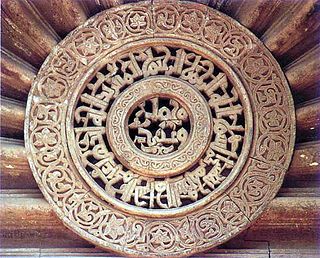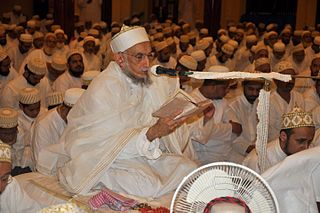
Isma'ilism is a branch or sect of Shia Islam. The Isma'ili get their name from their acceptance of Imam Isma'il ibn Jafar as the appointed spiritual successor (imām) to Ja'far al-Sadiq, wherein they differ from the Twelver Shia, who accept Musa al-Kadhim, the younger brother of Isma'il, as the true Imām.
The Musta‘lī are a branch of Isma'ilism named for their acceptance of al-Musta'li as the legitimate nineteenth Fatimid caliph and legitimate successor to his father, al-Mustansir Billah. In contrast, the Nizari—the other living branch of Ismailism, presently led by Aga Khan IV—believe the nineteenth caliph was al-Musta'li's elder brother, Nizar. Isma'ilism is a branch of Shia Islam.

The term Da'i al-Mutlaq literally meaning 'the absolute, or unrestricted, missionary', is the most senior spiritual rank and office in Tayyibi Isma'ilism. The Da'i al-Mutlaq has headed the Tayyibi community since the seclusion of the 21st Tayyibi Imam, at-Tayyib Abu'l-Qasim, traditionally placed in 528 AH/1134 AD.
The Sulaymani branch of Tayyibi Isma'ilism is an Islamic community, of which around 70,000 members reside in Yemen, while a few thousand Sulaymani Bohras can be found in India. The Sulaymanis are sometimes headed by a Da'i al-Mutlaq from the Makrami family.
Progressive Dawoodi Bohra also known as Bohra Youth is a reform movement within the Dawoodi Bohra subsect of Mustaali Ismai'li Shi'a Islam. They disagree with mainstream Dawoodi Bohra, as led by the incumbent Da'i al-Mutlaq, on doctrinal, economic, and social issues and broke off c. 1977.
The Atba-e-Malak community are a branch of Musta'ali Isma'ili Shi'a Islam that broke off from the mainstream Dawoodi Bohra after the death of the 46th Da'i al-Mutlaq, under the leadership of Moulana Abdul Hussain Jivaji Saheb in 1890. They are based in Nagpur in India. There are several hundred followers of this branch of Musta'ali Isma'ili Shi'a Islam. They have further split into two more branches:
The Hebtiahs Bohra were a branch of Mustaali Ismaili Shi'a Islam that broke off from the mainstream Dawoodi Bohra after the death of the 39th Da'i al-Mutlaq in 1754. They were mostly concentrated in Ujjain in India with a few families who were Hebtiah Bohra.

The Alavi Bohras are a Tayyibi Musta'lavi Isma'ili Shi'i Muslim community from Gujarat, India. In India, during the time of the 18th Fatimid Imam Al-Mustansir Billah around 1093 AD in Egypt, the designated learned people (wulaat) who were sent from Yemen by missionaries (du'aat) under the guidance of the imam established a da'wah in Khambhat.

Syedna Dhuʾayb ibn Mūsā al-Wādiʿī al-Hamdānī was the first dāʿī al-muṭlaq, a position of spiritual authority in Tayyibi Isma'ili Islam. He was appointed to the position by Queen Arwa al-Sulayhi.

Idris Imad al-Din was the 19th Tayyibi Isma'ili Da'i al-Mutlaq and a major religious and political leader in 15th-century Yemen, as well as a notable theologian and the most important medieval Isma'ili historian. His work is fundamental for the history of the Fatimid Caliphate and the Isma'ili communities in Yemen.
Syedna Dawood Bin Maulai Ajab Shah Burhanuddin in Ahmedabad, Gujarat, India was the 26th Da'i al-Mutlaq of the Dawoodi Bohra branch of Musta‘lī Islam. He succeeded the 25th Dai Syedna Jalal Shamshuddin bin Hasan to the religious post.
Syedna Ismail Badruddin (II) Bin Syedi Sheikh Adam was the 38th Dā'ī of the Dawoodi Bohras. He succeeded the 37th Da'i Syedna Noor Mohammad Nooruddin to the religious post.

Syedna Ibrahim Wajihuddin Bin Syedi AbdulQadir Hakimuddin was the 39th Dā'ī of the Dawoodi Bohras. He succeeded the 38th Dā'ī Syedna Ismail Badruddin II to the religious post.
Abbas ibn Muhammad was the 15th Da'i al-Mutlaq of Tayyibi. He succeeded the 14th Dai Syedna Abdul Muttalib to the religious post and was the 10th Dai from the lineage of al-Waleed.

Abu Taher Khuzaima Qutbuddin was the son of the 51st Da'i al-Mutlaq, half brother of the 52nd Da'i and a Mazoon of the Dawoodi Bohras, a subgroup within the Mustaali, Ismaili Shia branch of Islam. Qutbuddin was appointed as Mazoon by the Da'i al-Mutlaq, Syedna Muhammad Burhanuddin in 1965.

Syedna Jalal Shamshuddin bin Hasan was the 25th Da'i al-Mutlaq of the Dawoodi Bohra branch of Musta‘lī Ismaili Islam. He was the first Ismaili Dai in India after the shift of Daawat office from Yemen to India. He succeeded the 24th Dai Syedna Yusuf Najmuddin ibn Sulaiman to the religious post.
Syedna Ismail Badruddin (I) Bin Maulaya Raj was the 34th Da'i al-Mutlaq of the Dawoodi Bohras. He succeeded the 33rd Da'i Feer Khan Shujauddin to the religious post. Syedna Ismail became Da'i al-Mutlaq in 1085AH/1657AD. His period of Dawat was 1065–1085 AH/1657–1676 AD. He is the first Da'i descendant of Moulaya Bharmal.
Syedna Abduttayyeb Zakiuddin II was the 35th Da'i al-Mutlaq of the Dawoodi Bohras. He succeeded the 34th Dai Syedna Ismail Badruddin I to the religious post. Syedna Zakiuddin became Da'i al-Mutlaq in 1085 AH/1676 AD. His period of Dawat was 1085–1110 AH/1676–1692 AD. He is a descendant of Moulaya Bharmal.









